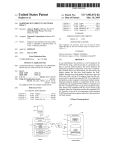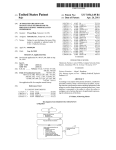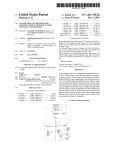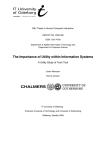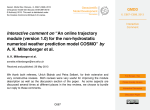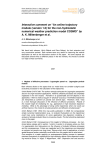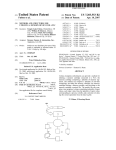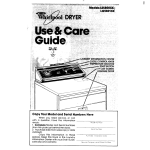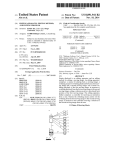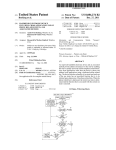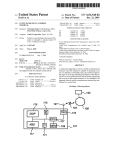Download Systems, methods, and computer program products for providing
Transcript
US008538006B1
(12) United States Patent
(10) Patent N0.:
Noble, Jr.
(54)
US 8,538,006 B1
(45) Date of Patent:
SYSTEMS, METHODS, AND COMPUTER
Sep. 17, 2013
2004/0210475 A1* 10/2004 Starnes et a1. ................ .. 705/11
PROGRAM PRODUCTS FOR PROVIDING
Zé‘éIiVIFNSTERFACES TO CALL
2006/0182258 A1 *
8/2006
Sisselman et al. ..... .. 379/265.02
2007/0172050 A1 *
7/2007
Weinstein et al. ..... .. 379/26607
OTHER PUBLICATIONS
“Agent Motivation Is Not All About Incentive Schemes,” http://WWW.
(75) Inventor;
J ames K, Noble, Jr,’ Marietta, GA (Us)
ca1lcentrehelper.com/agent-motivation-is-not-all-about-incentive
schemes-27447.htm, Feb. 22, 2012.
(73) Assigneez Noble systems Corporation, Atlanta’
Carlson, Lauren, Gami?cation: The Keyto Preventing SupportAgent
GA (Us)
Burnout, http://blog.softwareadvice.com/artrcles/crm/gamr?cation
preventing-support-agent-burnout-1022112/, Feb. 21, 2012.
_
_
(*)
Nonce:
(21)
Appl. No.: 13/459,524
(22)
Filed:
_
_
_
81113160t to any dlsclalmer: the term Ofthls
patent is extended or adjusted under 35
U.S.C. 154(b) by 0 days.
Hammarberg, Christina, “Gami?ed Helpdesk Concepts May Combat
Agent Burnout,” International Customer Management Institute, Mar.
1, 2012,
Noble Systems Corporation, Noble Composer 9 User Manual, Feb. 2,
2010, 428 pages, Atlanta, GA.
_
_
* c1ted by examlner
Apr. 30, 2012
Primary Examiner * Mohammad Islam
Assistant Examiner * Kharye Pope
(51) Int- ClH04M 3/00
G 0 6Q 10/00
G 0 6Q 30/00
(57)
ABSTRACT
.
.
.
.
Embodlments of the present 1nvent1on prov1de ‘computer pro
gram products, methods, and systems for prov1d1ng an rnter
(2006.01)
(201201)
(2012 01)
'
(52)
(58)
active interface to a particular agent of a plurality of call
US‘ Cl‘
center agents. In various embodiments, display criteria for
USPC ................. .. 379/265.06; 705/7.15; 705/1442
providing the interface are de?ned that relate to a perfor_
Field of Classi?cation Search
USPC ~~~~~~~~~~~~~~~ ~~ 379/265, 266; 370/352, 353, 354,
mance parameter associated With the plurality of call center
agents. Further, in various embodiments, interaction criteria
for providing an opportunity to interact With the interface are
de?ned that relate to a second performance parameter asso
ciated With the plurality of call center agents. Thus, in par
ticular embodiments, the interactive interface is provided to
the particular agent as a result of the agent having a measure
ment of the performance parameter meet the display criteria
and/or a measurement of the second performance parameter
meet the interaction criteria. Once the interactive interface
has been provided, the agent may be aWarded With an aWard
based on the agent’s interaction With the interface.
370/355, 356, 357
See application ?le for Complete Search history
(56)
References Cited
US. PATENT DOCUMENTS
5,239,460 A
5,483,444 A
8/1993 LaRoche
1/1996 HeintZeman et al.
6,044,355 A *
6,049,779 A *
3/2000
4/2000
Crockett et al.
Berkson ..... ..
...... ..
........... .. 705/739
705/1439
6,512,415 B1*
1/2003
KatZ
7,916,858 B1*
3/2011
Heller et al. ........... .. 379/26512
.. 379/8822
17 Claims, 10 Drawing Sheets
Network
-
V
Data Store
115
US. Patent
00?
Sep. 17, 2013
Sheet 1 0f 10
US 8,538,006 B1
US. Patent
Sep. 17, 2013
Sheet 2 0f 10
FIG. 2
1
Start
)
v
Receive
Selection of
210
Interface Type
v
Receive
Criteria for
215
Displaying
v
Receive
Criteria for
220
~
Interaction
v
Receive
225
Awards \>
230
Save
\B
US 8,538,006 B1
US. Patent
Sep. 17, 2013
Sheet 3 0f 10
US 8,538,006 B1
335
Edit Display
Receive
>
310
Criteria?
Selection of
Campaign
¢
Receive
Receive Edited
315
340
Display Criteria
Selection of
Shifts
¢
Receive
Selection of
Edit
320
NO
345
Interaction
Criteria?
Eligible Agents
Receive Edited
Another
Campaign?
Receive
Selection of
325
350
Interaction \x
Criteria
330
Edit Awards?
Interactive
Interface
360
Receive Edited
Awards \5
365
Another
Interface?
370
Save
FIG. 3
\J
US. Patent
Sep. 17, 2013
Sheet 4 0f 10
US 8,538,006 B1
FIG. 4
Detect
410
Completion of
Call
415
Determine
Agent \3
420
Retrieve
Crlterla
\)
425
Increment
Counter
440
435
Reset
Counter \5 445
Interaction
Criteria Met?
Retrieve
Information for
Interface
No
Display Award
7
Record
I
Provide
Interface to
Agent
@465
470
"
End
US. Patent
Sep. 17, 2013
Sheet 5 0f 10
FIG. 5
1
Start
)
v
Receive
Selection of
510
Report
v
Query
515
Information \5
v
520
Provide Report
for Display \5
v
End
US 8,538,006 B1
US. Patent
Sep. 17, 2013
Sheet 6 0f 10
You Made a Sale!!
Try Your Luckl!
AGENT
SLOTSH
FIG. 6
US 8,538,006 B1
US. Patent
Sep. 17, 2013
Sheet 7 0f 10
Nice Job on that Calllll!
US 8,538,006 B1
[E]
Lets Play Trivia!
710
Please Select the Correct
Answer Below and Select Enter.
in Handling a Callback, You Should Always...
0 Immediately Terminate the Call If No
One Answers After 3 Rings.
When Answered, Introduce Yourself
and Provide the Reason for Calling.
Q
720
When Answered, Immediately
Request Identification from Party.
t/@,, W
FIG. 7
US. Patent
Sep. 17, 2013
Sheet 8 0f 10
Nice Job on that Calll!!!
US 8,538,006 B1
E]
Lets Play Trivia!
Please Select the Correct
Answer Below and Select Enter.
In Handling a Callback, You Should Always...
0 Immediately Terminate the Call If No
One Answers After 3 Rings.
When Answered, Introduce Yourself
and Provide the Reason for Calling.
x Q When Answered, Immediately
Request Identification from Party.
@
A
Sorry that is Incorrect, the
Correct Answer is Checked
FIG. 8
US. Patent
Sep. 17, 2013
Sheet 9 0f 10
US 8,538,006 B1
WEEKLY SUMMARY
925
AGENT:
PAYROLL ID: 12345
915
930
LOCATIONI
TEAMI BLU
CH|CAGO\/
DATES; MARCH 12-16, 2012
910
920
Number of Sales
50
4O
50
- m\\\m\\\\\m\\\\\m\\\\\m\\m\mm\mm\\\\\\
\\\\\\\\\
\mmmmm\\\\\m\\\\\m\\\\\m\\\\\m\\m\m\\
20
we‘
0
I
'0" a
N§
I
'0'
N,Q
I
'0"
N“A
I
z‘"
'2»,
Nof
N(09
GAME SUMMARY
940
NUMBER OF CALLS FIELDED: 437\/
NUMBER OF PLAYS: 125\—/945
NUMBER OF vvms; 96L/950
9 5
WEEKLY AWARD: {513V 5
FIG. 9
US 8,538,006 B1
1
2
SYSTEMS, METHODS, AND COMPUTER
mance parameter associated With the call center agents. In
PROGRAM PRODUCTS FOR PROVIDING
INTERACTIVE INTERFACES TO CALL
CENTER AGENTS
addition, in various embodiments, interaction criteria for pro
viding an opportunity to interact With the interactive interface
to Win an aWard are de?ned and/ or recorded. Similar to the
display criteria, in particular embodiments, the interaction
BACKGROUND
criteria may be related to an interaction performance param
eter associated With the plurality of call center agents.
A call center is typically thought of a department used for
the purpose of receiving and transmitting a large volume of
communications, such as telephone calls. For instance, many
Depending on the embodiment, the process for providing
the interactive interface to the particular agent may involve
scheduling a time period for making the interactive interface
available to the plurality of call center agents. Further, the
companies Will provide call centers so that customers may
contact the centers in order to receive support for products
sold by the companies. Oftentimes, a call center involves the
use of a plurality of agents Who handle the communications.
HoWever, a major problem encountered in many call centers
process may involve providing the interactive interface on a
computer Workstation used by the particular agent, aWarding
the agent With the aWard based on the agent’ s interaction With
the interactive interface, and tracking and reporting the
aWarding of the aWard to the agent. In particular embodi
is agents become “burned out.” That is, many times, agents
ments, one or more steps of the process may be performed as
become to feel as though they have nothing left or any energy
left to give to their jobs or to the company they Work for. Such
feelings often lead to high turnover rates for agents. Experts
have pointed out contributing factors that lead to agent bum
out include lack of motivation and becoming uninterested in
performing the same tasks day-after-day.
To combat such factors, some employers have added ele
ments to an agent’s Workday to engage the agent in his daily
tasks and to, hopefully, boost agent retention. For instance,
a result of a measurement of the display performance param
eter for the particular agent meeting the display criteria and/or
20
the particular agent meeting the interaction criteria during the
time period.
In particular embodiments, the interactive interface may
include a game and the agent’s interaction involves playing
25
Workday is to incorporate gaming techniques into non-gam
ing applications to encourage participation. For example, a
interact With the interface.
counter may be incorporated into an agent’s Work screen that
30
In various embodiments, the interaction Work performance
may include one or more outcomes of a call. For example, in
particular embodiments, the outcomes may include one or
for during the day, keeps the agent engaged in his daily
activities, and promotes desired behavior.
HoWever, a problem often encountered in providing ele
the game. For instance, the game may be one of a roulette
Wheel, a slot machine, dice, or cards. Further, in particular
embodiments, the process may involve de?ning agent criteria
for identifying the plurality of call center agents that may
one technique employed to add such elements to an agent’s
keeps track of the number of calls the agent brings to a
resolution. The screen may also display the particular agent’ s
record for a day and/or the overall record for a day for all
agents. As a result, the counter gives the agent a goal to strive
a measurement of the interaction performance parameter for
35
more of the particular call being ansWered, a callback being
requested, an appointment being setup, or some other of type
of termination of the particular call. In other embodiments,
the outcomes may include one or more of a sale occurring, a
number of sales reaching a prede?ned number, a monetary
ments into an agent’s Work screen, like the counter described
above, is that such elements typically only keep the agent
value of a sale equaling at least a prede?ned amount, or a
engaged for a limited period of time before the agent becomes
disinterested in the elements. That is, many times, such ele
ments are considered simple and repetitive, and do not require
any direct interaction With the agent. In addition, With respect
to the counter example described above, the agent is likely to
number of items for a sale being at least a prede?ned number.
40
action performance parameter for a particular call handled by
the agent resulting in one of the outcomes.
Further, in various embodiments, second display criteria
set a record that becomes too hard to challenge on a daily
basis and thus, the agent feels like beating his record is highly
45
unlikely and, again, the agent becomes disinterested.
Thus, a need in the art exists for a process in Which a variety
of such elements may be developed, installed, scheduled,
managed, and reported for agents’ everyday Work activities.
Further, a need in the art exists for implementing elements
that involve direct interaction With agents. Furthermore, a
need in the art exists for a process that provides a variety of
incentives that may be tied to these elements to further moti
vate agents. It is With respect to these considerations and
others that the disclosure herein is presented.
50
55
for providing the interactive interface may be de?ned and/or
recorded. In these particular embodiments, the second dis
play criteria may be related to a second display performance
parameter associated With the plurality of call center agents.
LikeWise, in various embodiments, second interaction criteria
may be de?ned and/or recorded. In these particular embodi
ments, the second interaction criteria may be used for provid
ing a second opportunity to interact With the interactive inter
face to Win a second aWard. Further, in these particular
embodiments, the second interaction criteria may be related
to a second interaction performance parameter associated
With the plurality of call center agents.
For particular embodiments involving the second display
BRIEF SUMMARY
criteria and/or second interaction criteria, the process for
providing the interactive interface to the particular agent may
In general, embodiments of the present invention provide
computer program products, methods, systems, apparatus,
In these particular embodiments, the interactive interface
may be displayed as a result of the measurement of the inter
60
involve providing the interactive interface on a computer
Workstation used by the agent, aWarding the agent With the
and computing entities for providing an interactive interface
to a particular agent from a plurality of call center agents of a
second aWard based on the agent’ s second interaction With the
call center. In various embodiments, display criteria for pro
interactive interface, and tracking and reporting the aWarding
of the second aWard to the agent. In these particular embodi
viding the interactive interface on any one of a plurality of
computer Workstations used by the plurality of call center
agents are de?ned and/or recorded. In particular embodi
ments, the display criteria may be related to a display perfor
65
ments, one or more steps of the process may be performed as
a result of a measurement of the second display performance
parameter for the particular agent meeting the second display
US 8,538,006 B1
4
3
FIG. 6 is a screen display of an interactive interface in
criteria and/ or a measurement of the second interaction per
formance parameter for the particular agent meeting the sec
ond interaction criteria during the time period.
Further, embodiments of the present invention provide
accordance With various embodiments of the present inven
tion.
computer program products, methods, systems, apparatus,
in accordance With various embodiments of the present inven
tion.
FIG. 7 is a screen display of a second interactive interface
and computing entities for providing an interactive interface
FIG. 8 is a second screen display of the second interactive
interface shoWn in FIG. 7 in accordance With various embodi
ments of the present invention.
FIG. 9 is a screen display of an agent report in accordance
With various embodiments of the present invention.
FIG. 10 is an exemplary schematic diagram of a server used
in one embodiment of the call center architecture to practice
to a particular agent from a plurality of call center agents of a
call center that de?ne a ?rst aWard and a second aWard. In
these particular embodiments, the process for aWarding the
particular agent involves aWarding the agent With the ?rst
aWard based on the agent’s interaction With the interactive
interface and a measurement of a interaction performance
parameter meeting a ?rst result or aWarding the agent With the
the technologies disclosed herein.
second aWard based on the agent’ s interaction With the inter
active interface and the measurement of the interaction per
DETAILED DESCRIPTION
formance parameter meeting a second result.
Finally, embodiments of the present invention provide
computer program products, methods, systems, apparatus,
and computing entities for providing an interactive interface
Various embodiments for practicing the technologies dis
20
to a particular agent from a plurality of call center agents of a
call center that de?ne criteria for providing the interactive
interface on any of a plurality of computer Workstations used
that this disclosure Will satisfy applicable legal requirements
and should not be construed as limiting or precluding other
by the plurality of call center agents. In these particular
embodiments, the criteria may be related to a performance
parameter associated With the plurality of call center agents.
Depending on the embodiment, the process for providing
the interactive interface to the particular agent may involve
scheduling a time period for making the interactive interface
available to the call center agents. Further, the process may
closed herein are described more fully hereinafter With refer
ence to the accompanying draWings, in Which some, but not
all embodiments of the technologies disclosed are shoWn.
Indeed, the embodiments disclosed herein are provided so
25
embodiments applying the teachings and concepts disclosed
herein. Like numbers in the draWings refer to like elements
throughout.
Exemplary Call Center Architecture
FIG. 1 shoWs one embodiment of a call center architecture
30
100 illustrating the various technologies disclosed herein.
more steps of the process may be performed as a result of a
The call center shoWn in FIG. 1 may process voice calls that
are inbound-only, outbound-only, or a combination of both
(sometimes referred to as a “blended” call center). Although
many aspects of call center operation are disclosed in the
context of voice calls, in various embodiments, the call center
may process other forms of communication such as, for
measurement of the performance parameter for the agent
example, facsimiles, emails, text messages, video calls, and
meeting the criteria during the time period.
chat messages. Since the call center may handle calls origi
nating from a calling party, or initiated to a called party, the
term “party,” Without any further quali?cation, refers to a
involve providing the interactive interface on a computer
Workstation used by the particular agent, aWarding the agent
With an aWard based on the agent’s interaction With the inter
active interface, and tracking and reporting the aWarding of
the aWard to the agent. In particular embodiments, one or
35
This summary is provided to exemplify concepts at a high
level form that are further described beloW in the detailed
description section. The summary is not intended to identify
key or essential features of the claimed subject matter, nor is
it intended to be used to limit the scope of the claimed subject
matter. Furthermore, the claimed subject matter is not limited
to implementations that address any or all disadvantages
noted in any part of this disclosure.
40
person associated With a call processed by the call center,
Where the call is either received from or placed to the party.
The term “caller,” if used, Will generally refer to a party
45
BRIEF DESCRIPTION OF THE SEVERAL
calling the call center, but in many cases this usage is exem
plary. Thus, use of the term “caller” is not intended to limit the
concepts to only inbound calls unless the context dictates
such.
Depending on the embodiment, inbound voice calls may
originate from calling parties using a variety of different
VIEWS OF THE DRAWING(S)
50
phone types. For instance, a calling party may originate a call
Having thus described the invention in general terms, ref
from a conventional analog telephone 1101) connected to a
erence Will noW be made to the accompanying draWings,
Which are not necessarily draWn to scale, and Wherein:
public sWitched telephone netWork (“PSTN”) 115 using an
analog plain old telephone service (“POTS”) line 11611. The
55
calls may be routed by the PSTN 115 and may comprise
various types of facilities 116d, including, but not limited to:
T1 trunks, SONET based ?ber optic netWorks, ATM net
60
Ways, and other types of equipment may be involved in the
processing of the calls.
Inbound voice calls may also originate from a mobile
device 1100, such as a smart phone or tablet, Which Wirelessly
communicates With a mobile service provider (“MSP”) 112.
FIG. 1 shoWs one embodiment of a call center architecture
illustrating the various technologies disclosed herein.
FIG. 2 is a ?oWchart illustrating an interface development
module that can be used in accordance With various embodi
ments of the present invention.
FIG. 3 is a ?oWchart illustrating an interface installation
module that can be used in accordance With various embodi
ments of the present invention.
FIG. 4 is a ?owchart illustrating an interactive interface
execution module that can be used in accordance With various
embodiments of the present invention.
FIG. 5 is a ?oWchart illustrating a reporting module that
Works, etc. Various types of routers, sWitches, bridges, gate
The voice calls may be routed to the PSTN 115 using an
integrated services digital netWork (“ISDN”) interface 116!)
65
or other types of interfaces that are Well knoWn to those
can be used in accordance With various embodiments of the
skilled in the art. In particular embodiments, the MSP 112
present invention.
may also route calls as packetiZed voice, referred to herein as
US 8,538,006 B1
5
6
voice-over-IP (“VoIP”) to an Internet provider 1231) using
Internet-based protocols. For convenience, unless indicated
otherwise, the term “trunk” refers to any type of facility 1160,
11611, or 1160 providing voice calls to, or from, the call center,
regardless of the type of protocol or technology used. Spe
ci?cally, a “trunk” is not limited to time-division multiplex
station.” Thus, for these particular embodiments, the Work
station collectively has a data capability and a voice capabil
ity, although separate devices may be used. In some instances,
“Workstation” may be used in reference to either the data or
voice capability at the agent’s position. For example, “routing
the call to the agent’ s Workstation” means routing a call to one
ing (“TDM”) technology.
ofthe voice devices 16111-1610 at the agent’s position. Simi
larly, “routing the call to the agent” means routing a call to the
Inbound voice calls may also originate from a calling party
employing a so-called “IP phone,” “VoIP phone,” or “soft
phone” 11011. In one embodiment, this device may comprise
a computing device 105, such as a laptop or computing tablet,
Which interfaces With a headphone/microphone combination,
appropriate equipment at an agent’s position.
In particular embodiments, the voice device 16111-1610
used by an agent may be a soft phone device exempli?ed by
a headset 16111 connected to the computer 16011. The soft
phone device may be a virtual telephone implemented in part
by an application program executing on the computer 16011.
Further, the phone may also comprise an Internet Protocol
also referred to as a “headset” 106. An IP phone may use a
digital voice control protocol and may process packetiZed
voice data according to various Internet based voice proto
cols, such as session initiated protocol (“SIP”). The call may
be conveyed by other types of Internet providers 12311, such as
(“IP”) based headset 16119 or a conventional phone 1610. Use
of the term “phone” is intended to encompass all these types
of voice devices used by an agent, unless indicated otherWise.
a cable company providing Internet access services over a
Agents typically log onto their Workstations prior to han
coaxial cable facility 1160. Those skilled in the art Will rec
ogniZe that a variety of protocols and facilities may be used to
convey voice calls.
The term “telephone call” as used herein is generally syn
onymous With a “voice call” unless indicated otherWise. Fur
ther, the term “telephone call” may encompass a voice call
originating from any type of device, such as a soft phone
11011, conventional telephone, 110b, a mobile device 1100, or
20
that may be used to route a speci?c call to the agent or group
of agents having the same skill level. In particular instances,
25
calls in an e?icient manner.
attempt to establish tWo-Way communication, or a portion of
ventional telephone 1101) can dial a telephone call in an
attempt to establish tWo-Way communication, and a call can
be said to exist even prior to establishment of a tWo-Way
connection. In another example, a call may be put on hold,
and a portion of the call may be referred to as a “call leg”
if a suitable agent is not available to handle a call, the ACD
130 may queue the call for the next available agent. As can be
expected, various algorithms may be employed to process
other device knoWn in the art. The term “call” as used herein
may mean an active instance of tWo-Way communication, an
the tWo-Way communication. For example, a user at a con
dling calls. This alloWs the call center to knoW Which agents
are available for handling calls. In particular embodiments,
the ACD 130 may also maintain data of an agent’s skill level
30
In various embodiments, tWo types of signaling informa
tion may be provided With an inbound call that may be used by
the ACD 130 in processing the call. The ?rst type of signaling
information indicates the telephone number dialed by the
caller, and is frequently referred to as “DNIS,” derived from
the Dialed Number Identi?cation Service associated With this
call center may be received at an automatic call distributor
capability. For example, in particular instances, a call center
may provide various services, such as sales, customer service,
technical support, etc., each of Which may be associated With
a different telephone number (e.g., multiple toll free “800”
numbers). In these instances, the ACD 130 may use the DNIS
to determine the purpose of the call, and potentially identify a
group of agents having the appropriate skill level to handle the
call. Thus, in various embodiments, the ACD 130 may priori
(“ACD”) 130. In particular embodiments, the ACD 130 may
be a specialiZed sWitch for receiving and routing inbound
calls under various conditions. Further, the ACD 130 may be
tiZe and route calls to an agent based on the required skill
level. Skills-based routing may be a rule-based set of instruc
tions that the ACD 130 uses to handle calls. Depending on the
35
existing betWeen the caller and certain equipment. A call may
comprise a number of concatenated call legs, as knoWn to
those skilled in the art. In certain contexts, Which Will be made
explicit, the call may encompass communications other than
voice, for example, text messages, video chat, facsimile, etc.
40
In various embodiments, inbound calls from callers to the
45
embodied as a dedicated form of equipment readily available
embodiment, skills-based routing may be implemented by
from various manufacturers, or the ACD 130 may be a so
the ACD 130, or by the ACD 130 interacting With a computer
called “soft sWitch” comprising a suitable programming
module executed by a processing device to perform the nec
essary functions. The ACD 130 may route an incoming call
telephone integrated (“CTI”) server 145.
50
In various embodiments, the CTI server 145 may be incor
porated in the call center architecture 100 to control and/or
coordinate other components of the architecture 100. Speci?
over call center facilities 165 to an available agent. Depend
ing on the embodiment, the facilities 165 may be any suitable
cally, the CTI server 145 may interact With the ACD 130 to
technology for conveying the call, including but not limited to
coordinate call processing. Thus, in particular embodiments,
a local area netWork (“LAN”), Wide area netWork (“WAN”),
ISDN, or conventional TDM circuits. In addition, the facili
55
ties 165 may be the same or different from the facilities used
to transport the call to the ACD 130.
In various embodiments, calls may be routed over facilities
145 may also provide call reporting functionality based on
data collected during calls.
The second type of signaling information that may be
165 to an agent for servicing. That is, for example, the party
may speak With an agent to receive customer service. The
physical area at Which the agent sits is often referred to as an
60
provided With an inbound call is the calling telephone num
ber, often referred to as automatic number identi?cation or
agent “position” and these positions are often grouped into
clusters managed by a supervisor, Who may monitor calls and
the agents’ productivity. An agent typically uses a computing
device 16011-160b, such as a computer, and a voice device
the CTI server 145 may control routing of calls from the ACD
130 to the various agent Workstations and/ or may provide
data to other components processing the calls. The CTI server
“ANI.” In particular embodiments, the ACD 130 and/or CTI
server 145 may use the ANI of an incoming call to retrieve
65
caller information from a data store 175 and provide the data
to an agent’s Workstation computer 16011-1600 over facilities
16111-1610. The combination ofcomputing device 16011-1600
168 along With routing the call to the agent’s Workstation
and voice device 16111-1610 may be referred to as a “Work
phone 16111-1610. Further, in particular embodiments, the
US 8,538,006 B1
7
8
ANI may also be used to ascertain a party’s status (e.g., a
how and when to dial a list of numbers so as to minimiZe the
“Gold Level” customer warranting premium service) and/or
likelihood of a called party being placed in a queue while
to facilitate the ACD 130 routing the call to a select group of
maintaining target agent utiliZation.
agents. Depending on the embodiment, the data store 175
Another server that may be employed in the call center
architecture 100 is a workforce management (“WFM”) server
155. In various embodiments, this server 155 maintains infor
may include one or more databases storing different informa
tion such as, for example, records of caller information. Fur
ther, the data store 175 may be integrated with the CTI server
mation to generate agents’ schedules to effectively handle
inbound/outbound calls. For instance, in particular embodi
145, the ACD 130, or segregated as a standalone medium or
media.
In various embodiments, the ACD 130 may place a call in
ments, the WFM server 155 may maintain historical call
volume information for call campaigns and may forecast
expected call volume to predict the number of agents needed
a queue if there are no suitable agents available, and/or it may
route the call to an interactive voice response server (“IVR”)
to handle the call volume at a de?ned service level. The WFM
135 to play voice prompts. In particular embodiments, these
server 155 may then apply information about available agents
to generate a work roster of agents. In other words, the WFM
server 155 may schedule agents for their work shifts accord
prompts may be in a menu type structure and the IVR 135
may collect and analyZe responses from the party in the form
speech. In addition, the IVR 135 may be used to further
ing to the anticipated needs of the call campaigns.
Finally, in various embodiments, the call center architec
identify the purpose of the call, such as, for example, prompt
ture 100 may include one or more other servers 156 to per
of dual-tone multiple frequency (“DMTF”) tones and/or
form various functions. For example, in one particular
ing the party to enter account information or otherwise obtain
information used to service the call. Further, in particular
embodiments, the IVR 135 may interact with other compo
20
embodiment, the call center architecture 100 includes a server
156 to serve as a quality assurance system that records com
nents, such as the CTI server 145 or the data store 175, to
munications ?elded by agents and/or allows managers to
retrieve or provide information for processing the call. In
other con?gurations, the IVR 135 may be used to only pro
monitor communications to ensure these communications are
vide announcements.
being handled correctly.
25
Although the above components are referred to as “serv
ers,” each may be also referred to in the art as “units” or
“systems.”A server may incorporate a local data store and/or
interface with an external data store. Use of the word “server”
does not require the component to interact in a client-server
30
arrangement with other components, although that may be the
case. Further, the above components may be located remotely
Depending on the embodiment, the interaction between the
ACD 130, IVR 135, CTI server 145, agent computers 160a
160c, as well as other components, may involve using a local
area network (“LAN”) 170. However, other con?gurations
are possible, such as, but not limited to, using a wide area
network, wireless network, router, bridge, direct point-to
point links, etc.
from (or co-located with) other components. Furthermore,
In particular embodiments, when an agent is interacting
one or more of the components may be implemented on a
single processing device to perform the functions described
with a called or calling party, the agent may use his worksta
tion computer 1601) to further interact with other enterprise
computing systems, such as, for example, a customer rela
tionship management (“CRM”) server 140. A CRM server
140 may be used to integrate information from various enter
prise business systems to facilitate the agent servicing the
call. In addition, the CRM server 140 may provide a variety of
35
functionalities of the ACD 130, IVR 135, CRM server 140,
CTI server 145, PD 150 and/or WFM server 155 may be
40
applications.
In addition to receiving inbound communications, includ
ing, for example, voice calls, emails, text messages, and fac
similes, the call center may also originate communications to
a called party, referred to herein as “outbound” communica
tions. In some embodiments, a call center may employ a
herein. For example, in various embodiments, one or more
45
combined into a single hardware platform executing one or
more software modules. In addition, the call center architec
ture 100 may be provided as a hosted solution, where the call
processing functionality is provided as a communication ser
vice (a so-called “communication as a service” or “CaaS”) to
a call center operator. Thus, there is no requirement that the
servers identi?ed above actually be located or controlled by a
call center operator.
In addition, depending on the embodiment, the agent posi
predictive dialer (“PD”) 150 to originate outbound calls on
tions may be co-located in a single physical call center or
behalf of an agent at a rate designed to meet various criteria.
multiple physical call centers. The agents may be remotely
Similar to the other components within the call center archi
tecture 100, depending on the embodiment, the PD 150 may
50
located from the other components of the call center, and may
also be remotely located from each other, sometimes referred
to as a “virtual call center.” In particular instances, a virtual
call center may describe a scenario in which agents work at
comprise one or more software modules executing on a pro
cessing device hardware platform.
In various embodiments, the PD 150 is typically con?g
ured to dial a list of telephone numbers to initiate outbound
calls, which can be accomplished by instructing the ACD 130
to originate the calls. Thus, in some embodiments, the ACD
130 may include functionality for originating calls, and if so,
this functionality may be referred to as a private automatic
branch exchange (“PBX” or “PABX”). In other embodiments
55
(not shown), the PD 150 may directly interface with voice
trunks using facilities 1160, 116d, 116e to the PSTN 115
and/ or Internet providers 12319 for originating calls. After the
calls are originated, a transfer operation by the ACD 130 may
60
home, using their own computers and telephones as worksta
tions. In some con?gurations, a single physical location of the
call center may not be readily identi?able. For instance, this
may occur when the call processing functions are provided as
a service in a hosted cloud computing environment and the
agents positions are in their individual residences.
Those skilled in art will recogniZe FIG. 1 represents one
possible con?guration of a call center architecture 100, and
that variations are possible with respect to the protocols,
facilities, components, technologies, and equipment used.
For example, various algorithms and queuing arrangements
may be provided to the party. In various embodiments, the PD
may be de?ned to e?iciently process calls. In other con?gu
rations, the ACD 130 may be con?gured to process not only
voice calls, but also other forms of communication, and per
150 may make use of one or more algorithms to determine
form corresponding call processing functions for email, text,
connect the call with an agent, or place the call in a queue for
an available agent. In the latter case, announcements or music
65
US 8,538,006 B1
10
text communications, as well as interact with other call center
type. While in another embodiment, the design interface pro
vides drag-and-drop functionality and the user drags and
drops the desired interactive interface type from a listing onto
components.
a design screen. Thus, the user selects the desired interactive
Exemplary System Operation
interface type and the ID module receives the selection,
chats, or facsimile calls. Alternatively, a web server (not
shown in FIG. 1) may receive or originate email, chats, and
The logical operations described herein are implemented
shown as Step 210.
Next, the user enters criteria for displaying the interactive
interface and the ID module receives the criteria, shown as
(1) as a sequence of computer implemented acts or one or
more program modules running on a computing system and/
or (2) as interconnected machine logic circuits or circuit
Step 215. The display criteria de?ne what actions and/or
modules within the computing system. The implementation is
conditions must occur in order for the interactive interface to
a matter of choice dependent on the performance and other
be made available to an agent. For instance, during a call
center campaign, the call center operator may only want the
interactive interface to become available to an agent after
requirements of the computing system. Accordingly, the lo gi
cal operations described herein are referred to variously as
every ?fth call the agent has ?elded. That is, for example, the
states, operations, structural devices, acts, or modules. These
operations, structural devices, acts, and modules may be
call center operator may only want the interactive interface to
popup on the agent’s workstation after every ?fth call ?elded
implemented in software, in ?rmware, in special purpose
by the agent. Thus, the display criteria control how often an
agent is given an opportunity to interact with a particular
digital logic, and any combination thereof. Greater or fewer
operations may be performed than shown in the ?gures and
described herein. These operations may also be performed in
a different order than those described herein.
20
Interface Development Module
interface.
It should be noted that making the interactive interface
available to an agent may differ in various embodiments. For
Turning now to FIG. 2, additional details will be provided
regarding the process ?ow for developing interactive inter
instance, in certain embodiments, making the interactive
faces. In particular, FIG. 2 is a ?ow diagram showing an
popup and display on the agent’s workstation automatically.
While in other embodiments, making the interactive interface
interface development (ID) module for performing such func
interface available to an agent involves having the interface
25
tionality according to one embodiment of the invention. For
available to an agent involves providing some mechanism to
example, the ?ow diagram shown in FIG. 2 may correspond
the agent so that the agent may open and display the interface
to steps carried out by a processor in a computing device, such
on his workstation, such as, for example, a button on the
as the WFM server 155, as it executes the ID module stored in
agent’s workstation that the agent may select.
Similar to the selecting the interface type, the design inter
the computing device’s volatile and/or nonvolatile memory.
In various embodiments, to facilitate the design and develop
30
ment of an interactive interface, a user, such as a call center
face may be con?gured in a number of different ways that
allow the user to enter the display criteria. For instance, in one
administrator for example, is provided with a design interface
in communication with the ID module. The design interface
user simply selects the appropriate criteria. In other embodi
embodiment, the display criteria may be pre-de?ned and the
may comprise one or more screens from which the user may 35 ments, the user may have more freedom to de?ne the display
design and develop an interactive interface to be used in
criteria. For example, in one embodiment, the design inter
conjunction with an agent’s workstation during the agent’s
face may provide the user with ad hoc capabilities so that the
user may enter criteria that apply to a speci?c solution. Fur
workday.
In various embodiments, the ?rst step in developing an
interactive interface is selecting the interactive interface type.
Accordingly, depending on the embodiment, the design inter
ther, in various embodiments, the criteria may be related to
40
example, the criteria may include a ?eld that de?nes the
number of calls that need to be handled (e.g., ?elded) by an
agent before the interactive interface is made available to the
face may provide the user with a number of different options
for the interactive interface type. For instance, in particular
embodiments, the design interface may provide the user with
any number of interactive interface types that include a game
of chance for the agent to play when the interface appears on
45
the agent’s workstation. Games of chance are generally
user with interactive interface types that include games of
skill in addition to or instead of games of chance. Games of
skill are generally understood to be games that involve some
outcome that is determined mainly by one or more mental
50
55
mance parameters may be set for the criteria described above.
For example, in one embodiment, the user may not only
indicate how many calls must be ?elded before the interface
60
is made available, but may also indicate how the calls should
be ?elded before the interface is made available. For instance,
each call ?elded by an agent may have a termination code
indicating the outcome of the call. For example, the outcome
of the call may have been the party requesting a callback, the
party not answering the call, the phone line being busy, the
party indicating not to be called, the party setting up an
appointment, an answering machine answering the call, the
phone line becoming disconnected, and so forth.
interface type. While in another embodiment, the design
interface may provide a listing of available interactive inter
face types, and the user selects the desired type by checking a
corresponding checkbox by the desired interactive interface
For instance, if the user enters the number two, the interface
will be made available to the agent after every third call
?elded by the agent.
In addition, depending on the embodiment, other perfor
and/or physical skills of the player. For example, games of
skill may include checkers, chess, trivia, and tic-tac-toe.
Further, depending on the embodiment, the design inter
face may provide the user with a number of options to identify
the desired interactive interface type. For example, in one
embodiment, the design interface may include a dropdown
option from which the user may select the desired interactive
agent. In this particular example, the user may enter a Zero to
indicate that the interface should be made available to the
agent after every call the agent ?elds. The user may enter a
number (e.g., l, 2, or 3) to indicate how many calls should be
skipped before the interface is made available to the agent.
understood to be games that involve some outcome strongly
in?uenced by some random factor out of the control of the
player. For example, games of chance may include card
games, dice games, roulette, and baccarat. In addition, in
various embodiments, the design interface may provide the
performance parameters associated with agents. For
65
The performance parameters could also be based on non
voice call related activities performed by the agent. For
example, the performance parameters could specify a number
US 8,538,006 B1
11
12
of emails from users that are processed or resolved by the call
other performance parameters. For example, the user may set
up display criteria for making the interactive interface avail
able to an agent for every ?fth call ?elded by an agent, and the
agent. The performance parameters could specify a number
of chat sessions that the agent must be involved With, or short
message service messages that are handled. Although the
embodiments illustrated herein are presented in the context of
calls that count are calls that result in an outcome of a party
ansWering the call, a party requesting a callback, or a party
setting up an appointment. Further, the user may set up inter
action criteria that require the outcome of the ?fth call to be
either the party requesting a callback or the party setting up an
the agent handling voice calls for purposes of illustration and
not for limitation, those skilled in the art Will recogniZed in
light of the present disclosure that the principles of the tech
nologies disclosed herein can be applied to a variety of tasks
routinely handled by a call center agent.
appointment. Therefore, in this example, if an agent ?elds his
?fth call and the outcome of the call is the party setting up an
Thus, the user may select one or more of these termination
appointment, the agent is provided the opportunity to interact
codes to indicate the call must result in a particular outcome
for the call to count toWards making the interactive interface
available to an agent. For example, if the user selects the
termination codes associated With the outcome being one of
With the interface.
As described in further detail beloW, in various embodi
ments, the interaction may entail any number of different
the party requesting a callback, the party ansWering the call,
the interactive interface. For instance, in one embodiment, the
interface may be a roulette Wheel that has monetary values set
or the party setting up an appointment and a call is ?elded by
an agent that is terminated because the party does not ansWer
the call, then the call Will not count toWards the requirement
to make the interactive interface available to the agent.
Depending on the embodiment, at the end of a call, the agent
actions, interplays, contacts, interchanges, or exchanges With
for each section of the Wheel. Therefore, the agent is provided
20
clicks on a button entitled “SPIN” on the interactive interface
may be provided With one or more screens that alloW the agent
to select the outcome of the call or one or more components of
the call center architecture 100 may monitor certain param
eters to determine the outcome of the call.
It should be apparent to those of ordinary skill in the art in
25
light of this disclosure that other types of performance param
eters may be used as display criteria besides phone calls
and/or termination codes. For example, in various embodi
ments, display criteria may be based on a sale occurring, a
number of sales reaching a prede?ned number, a monetary
value of a sale equaling at least a prede?ned amount, a num
ber of items for a sale equaling at least a prede?ned number,
a number of appointments set up by parties reaching a pre
de?ned number, a number of callbacks requested by parties
reaching a prede?ned number, and so-forth. Further, in par
the opportunity to “spin the roulette Wheel” as a result of the
?fth call’ s outcome meeting the interaction criteria. The agent
30
and the Wheel spins and stops on a particular section of the
Wheel having a particular monetary amount. As a result, the
agent is aWarded the particular monetary amount as a bonus in
addition to the agent’s normal pay.
Further, the interaction criteria may be de?ned for different
levels. For instance, in one embodiment, the interaction cri
teria may be de?ned so that an agent is provided the oppor
tunity to interact With the interface the ?rst time as a result of
the outcome of the ?fth call being an ansWered call, a party
requesting a callback, or a party setting up an appointment.
However, after the ?rst interaction, the agent is only provided
subsequent interactions if the outcome of the ?fth call results
in a party requesting a callback or a party setting up an
35
appointment. As described in greater detail beloW, in particu
lar embodiments, each time an agent is provided an opportu
ticular embodiments, the criteria may be related to other
nity to interact With the interface, the agent’s interaction
performance parameters not directly linked to Work perfor
information is stored so that such information may be refer
mance, such as the completion of an online training session
by an agent. Therefore, the speci?c criteria described above
are only provided as examples of display criteria that may be
40
used and should not be construed to limit the scope of the
invention.
Further, in various embodiments, multiple interactive
interfaces may be made available to agents at the same time
45
during a campaign. For these particular embodiments, the
comprise any number of different items such as, for example,
money, extra break time, paid time off, dinner, event tickets,
and so-forth. For instance, returning to the example involving
user may also set a parameter (e. g., ?eld) to indicate Whether
particular criteria (e.g., ?elded calls) count toWards making
multiple interactive interfaces available or Whether the crite
ria only count toWards making one or more particular inter
50
active interfaces available. Thus, in particular embodiments,
55
module con?gures the roulette Wheel to have three sections,
the ?rst section is allotted half the Wheel (50%) and has a
monetary value of $1, the second section is allotted 30% of
the Wheel and has a monetary value of $2, and the third
60
of $3. Thus, by entering the values (e.g., percentages) asso
addition to providing display criteria for making the interac
tive interface available to agents, the user may also provide
interaction criteria for providing an agent an opportunity to
interact With the interactive interface. Thus, in these particu
lar embodiments, once an agent is provided the opportunity to
interact With a particular interactive interface, the agent
the roulette Wheel, the user enters a list of aWards that may be
available on the roulette Wheel such as $1, $2, and $3. Next,
the user enters values to de?ne the relative odds of Winning
each aWard. The user enters a percentage for each aWard such
as 50% for $1, 30% for $2, and 20% for $3.As a result, the ID
criteria may be set up for multiple interactive interfaces or
may be set up for individual interactive interfaces.
Retuning noW to FIG. 2, in Step 220, the ID module
receives criteria for interaction. In various embodiments, in
enced. As a result, such storage alloWs for components of the
call center architecture 100 to implement different levels of
criteria. As can be envisioned, similar to the interaction cri
teria, different levels of display criteria may also be de?ned in
various embodiments.
In Step 225, the ID module receives the aWards information
de?ning What the aWards are for the particular interactive
interface. Depending on the embodiment, the aWards may
section is allotted 20% of the Wheel and has a monetary value
ciated With the different aWards, the user has dictated the odds
engages in some type of interaction With the interface, and
based on the interaction, the agent may Win an aWard.
of Winning each aWard.
Similar to the display criteria, in various embodiments, the
interaction criteria may also involve performance parameters
associated With agents, such as the performance parameters
this disclosure, the aWards on the Wheel may cover a range of
already discussed With respect to the display criteria as Well as
As one of ordinary skill in the art can envision in light of
65
different aWards in both amount and type. For example, the
aWards may not only be monetary, but may also include other
types of aWards such as gift certi?cates, dinners, event tickets,
US 8,538,006 B1
13
14
and so forth. In addition, the awards may not be awards at all,
per se, but instead may include instances in Which the agent is
In various embodiments, the parameters of the campaign
typically de?ne the time period for Which the campaign Will
not a Winner. For example, one or more sections of the Wheel
run, the shifts that Will occur during the time period, and the
agents that Will be assigned to the shifts. Therefore, the user
can simply indicate that the interactive interface(s) Will be
may be marked With a message that reads, “Sorry you are not
a Winner at this time, please qualify and try again!”
As Will be understood by those of ordinary skill in the art,
similar to the display criteria and the interaction criteria, the
active for the entire time period and for all the agents during
all of the shifts. HoWever, in some instances, the user may not
Wish to have the interactive interface active for the entire
aWards may be de?ned for different levels. For instance,
returning to the example, the ?rst time an agent quali?es for
an aWard and “spins” the roulette Wheel, the sections may be
marked as $1, $2, and $3. Each time thereafter, the sections
may be marked as $2, $3, and $4. Further, depending on the
campaign. Therefore, in various embodiments, the user may
indicate What shifts (e. g., time periods during the campaign)
the user Would like to make the interactive interface available
and/or Which agents the user Would like to make the interac
tive interface available to. For example, the call center opera
tor may Wish to implement an interactive interface that is
active only during the Week of Christmas as a reWard for those
agents Who are Willing to Work this Week, since the Week is a
embodiment, the user may be able to set other features for the
interactive interface by using the design interface. For
example, the user may be able to specify font types for text,
screen colors, and other visual features. In addition, the user
may be able to specify sounds for various features of the
interface, such as sounds of the roulette Wheel turning and/or
voice simulations informing the agent he is a Winner.
At this point, the user may select to save the interactive
interface (e.g., the user may click the “SAVE” button on a
screen of the design interface). Accordingly, the ID module
saves the information (e.g., the interactive interface type,
criteria, and other feature data) for the interface, shoWn as
Step 230. Following the step of saving the information for the
popular time for agents to request vacation.
In such cases, the user indicates the desired shifts and/or
20
agents. For example, in one embodiment, the design interface
provides a listing of the shifts and/ or agents along With check
boxes for each shift and/or agent and the user simply checks
the appropriate boxes. As a result, the II module receives a
25
selection of the shifts and/or eligible agents, as shoWn in Steps
315 and 320. It should be noted that in particular embodi
ments, the user may indicate criteria for identifying eligible
interactive interface, the interface is noW available for use
With one or more campaigns conducted by the call center.
shifts and/or agents instead of identifying the speci?c shifts
and/or agents, themselves. Therefore, for these particular
Interface Installation Module
Turning noW to FIG. 3, additional details Will be provided
embodiments, the shift criteria and/ or agent criteria are con
regarding the process How for installing interactive interfaces
sidered in determining Whether an agent is eligible to have the
30
for one or more campaigns. The term “campaign” generally is
understood to mean a set of parameters that de?ne commu
nications to take place to achieve a marketing and/or infor
mation activity such as, for example, placing calls, receiving
calls, and/ or and sending emails to a number of customers of
paign. As a result, in Step 325, the II module determines the
35
an insurance company to inform them of a neW insurance
product they may purchase. The parameters of a campaign
generally de?ne the Who, What, and When of the campaign.
40
numbers, and/or email addresses), the content of the commu
nications, and the time period in Which the communications
Will be handled.
FIG. 3 is a How diagram shoWing an interface installation
(II) module for performing functionality associated With
user Wishes to select another campaign and the module
returns to Step 310 of the process How. As this point, the
process How repeats as described above until the user has
?nished selecting all of the campaigns for Which to apply the
For instance, the parameters of a campaign may de?ne Who
Will make/receive the communications (e.g., parties, phone
interface made available to him.
Next, if the user Would like to apply the interactive inter
face to more than one campaign, the user indicates on the
design interface that he Would like to select another cam
45
interactive interface.
The user then selects the desired interactive interface he
Wishes to install in the selected campaign(s). As previously
described, in many instances, the interactive interfaces have
been previously built and the user simply selects the designed
interface from a library of available interfaces. HoWever, in
some embodiments, the design interface used for installing an
installing interactive interfaces for one or more campaigns
interactive interface into one or more campaigns may also
according to one embodiment of the invention. Accordingly,
the How diagram shoWn in FIG. 3 may correspond to steps
carried out by a processor in a computing device, such as the
include one or more screens con?gured to alloW the user to
build a neW interface from scratch. Once the user selects an
WFM server 155, as it executes the II module stored in the
interface, the II module receives the selection, shoWn as Step
50
computing device’s volatile and/or nonvolatile memory.
In various embodiments, the user opens a design interface
the selection.
At this point, the user may Wish to install the interface With
associated With the II module, similar to or the same as the
design interface used in conjunction With the ID module. In
particular embodiments, the WFM server 155 possesses
55
access to information on campaigns that have been built by
one or more users on the WFM server 155. Thus, a user may
use the design interface to vieW and select a particular cam
paign to have one or more interactive interfaces installed. As
can be envisioned by those of ordinary skill in the art, the
design interface may utiliZe any number of mechanisms for
Therefore, in these particular embodiments, the II module
determines Whether the user Would like to edit the display
criteria, shoWn as Step 335. If so, the II module then receives
displaying and alloWing selection of the campaign. For
desired campaign from the listing. As a result, in Step 310, the
II module receives the selection of the campaign.
the criteria and aWards already de?ned for the interface, such
as the display criteria, the interaction criteria, and the aWards,
themselves. HoWever, in various embodiments, if the user
Wishes to edit any of the criteria and/or aWards, the design
interface provides capabilities so that the user may do so.
60
the edited display criteria, shoWn as Step 340. For example,
returning to the roulette Wheel interface, the display criteria
instance, in one embodiment, the design interface may make
use of a drop-down menu that lists all of the active campaigns
that have been built for the call center and the user selects the
330. For instance, returning to the previous example involv
ing an interactive interface for a roulette Wheel, the user
selects the roulette Wheel interface and the II module receives
65
Was de?ned as making the interface available to an agent for
every ?fth call ?elded by the agent in Which the outcome of
the call resulted in a party ansWering the call, a party request
US 8,538,006 B1
15
16
ing a callback, or a party setting up an appointment. The user
may Wish to change the criteria to every fourth call. The user
IIE module may be con?gured to detect When an agent has
opened an email from a party or has sent an email to a party.
edits the display criteria and, accordingly, the II module
Thus, With respect to the process How described in FIG. 4, the
IIE module is con?gured to detect the completion of calls
receives the edited criteria With the number of calls changed
to every fourth call ?elded by an agent instead of every ?fth
call.
As mentioned, the II module may also be con?gured in
either received from or sent to various parties. Although, as
mentioned, it should be understood that in various embodi
ments, the IIE module may be con?gured to detect other
features of communication, such as for example, calls being
various embodiments to alloW the user to edit the interaction
criteria and the aWards. Thus, in Step 345, the II module
determines Whether the user Would like to edit the interaction
criteria. If so, the II module receives the edited interaction
ansWered, average call handling time, call disposition, text
10
being setup, etc.
Looking at FIG. 4, the IIE module detects the completion
criteria, shoWn as Step 350. Similarly, in Step 355, the II
module determines Whether the user Would like to edit the
of a call Within the call center architecture 100, shoWn as Step
410. For example, in one embodiment, the IIE module may
detect When a particular call has been disconnected betWeen
an agent and a party. The disconnection may have occurred
aWards. If so, the II module receives the edited aWards, shoWn
as Step 360. It should be noted that depending on the embodi
ment, the edited criteria and/or aWards may be saved in place
of (e.g., overWrite) the original criteria and/ or aWards for the
interactive interface or the edited criteria, along With the other
for a number of different reasons. For instance, the discon
nection may have occurred because the agent and the party
Were through With the call and the tWo mutually hung up the
information on the interface, may be saved as a neW interac
tive interface. Thus, in particular embodiments, the interac
messages being ansWered, sales being made, appointments
20
call, or the disconnection may have occurred because no one
templates that can be used to build speci?c interfaces for
ansWered the call or the number dialed may have been dis
connected and no longer in service. While in another
particular campaigns.
example, the IIE module may detect the completion of the call
tive interfaces built through the ID module may also serve as
as a result of the agent handling the call setting an indicator
At this point, the user may Wish to install an additional
interactive interface into the campaign(s). Therefore, in Step
25
365, the II module determines Whether the user Wishes to
install another interactive interface. If so, the II module
returns to the point in the process Where the user selects the
interactive interface (Step 330) and the process described
above is repeated for the neWly selected interface. Once the
30
user is done selecting interfaces, the II module saves the
information on the selected campaign(s) and interactive inter
face(s), shoWn as Step 370. As a result, the selected interfaces
are inserted (installed) in the operational screens to be used by
the agents during the campaign(s) so that the interfaces can be
that the call has been completed.
After detecting the completion of the call, the IIE module
determines the agent associated With the completed call,
shoWn as Step 415. For instance, in one embodiment, each
agent is associated With a unique identi?er such as a payroll
number. When a particular call is route to an agent, the call is
associated With the unique identi?er Within the call center
architecture 100. That is, for example, an identi?er for the call
is associated With the unique identi?er for the agent and the
relationship is stored in a record in a database located on some
35
data store 175 Within the call center architecture 100. In this
made available to the agents during the campaign(s).
It should be noted that during the campaign(s), in various
particular instance, the IIE module queries the database for
the unique identi?er for the agent to determine What agent
embodiments, the one or more components of the call center
architecture 100 used to control the call center process for
handled the call.
Next, the IIE module retrieves the criteria associated With
the appropriate interactive interface, shoWn as Step 420. For
communications are con?gured to monitor the display and
interaction criteria and to take the appropriate actions (e.g.,
display the interactive screen and/or issue the aWards) based
on the criteria. For instance, as described in greater detail
beloW, the CTI server 145 in particular embodiments may be
con?gured to carry out such functionality.
Interactive Interface Execution Module
Turning noW to FIG. 4, additional details Will be provided
40
instance, in particular embodiments, the IIE module retrieves
display criteria, interaction criteria, and/or any other appli
cable criteria. Depending on the embodiment, the IIE module
may retrieve the criteria based on certain information that
45
regarding the process How for executing interactive interfaces
during one or more campaigns. Speci?cally, FIG. 4 is a How
diagram shoWing an interactive interface execution (IIE)
module for performing functionality associated With execut
50
pertains to the particular agent. For instance, as previously
described, the interactive interface may be con?gured to have
different levels of display criteria and/or interaction criteria
based on the agent’s history With the interactive interface. For
example, the interactive interface may be con?gured With a
?rst set of display criteria to be used for making the interface
available to an agent a ?rst time and a second set of display
ing interactive interfaces during one or more campaigns
according to one embodiment of the invention. Accordingly,
criteria to be used for making the interface available to the
the How diagram shoWn in FIG. 4 may correspond to steps
may ?rst query information on the agent’s history on inter
acting With the interface to determine Which criteria are
appropriate to apply to the call. It shouldbe noted that in some
carried out by a processor in a computing device, such as the
agent for any subsequent times. Therefore, the IIE module
55
CTI server 145 or an agent’s computer 160a-160c, as it
executes the IIE module stored in the computing device’s
volatile and/or nonvolatile memory. Further, in particular
embodiments, a call center hosting arrangement can provide
the interactive interface to an agent by interacting With a
60
broWser WindoW and using HTML/JavaScript protocols on
the agent’s computer 160a-160c.
As Will be apparent to those of ordinary skill in the art in
light of this disclosure, the IIE module may be con?gured to
detect various features of communications in order to evalu
ate Whether to make an interactive interface available for a
particular agent. For instance, in particular embodiments, the
65
embodiments, the IIE module may not only query informa
tion to determine the appropriate criteria, but may also query
information to determine the appropriate interface to apply to
the call.
FolloWing retrieval of the criteria, the IIE module deter
mines Whether the agent is eligible to have the interactive
interface made available to him, shoWn as Step 425. Thus, in
various embodiments, the retrieved criteria may include
information that speci?cally indicates Whether the agent is
eligible. While in other embodiments, the retrieved criteria
may include shift criteria and/or agent criteria that provide
US 8,538,006 B1
17
18
conditions the agent must meet in order to eligible. For
example, the agent criteria may indicate that an agent must be
?es toWards the agent’s count for making the interactive
on a particular team in order to have the interactive interface
not met the requirements set for the display criteria (e.g., the
counter is less than three), the IIE module increments the
interface available to the agent and the current counter does
made available to him. Therefore, if the IIE module deter
mines the agent is not eligible, the IIE module exits Without
performing further steps to make the interface available to the
counter by one, shoWn as Step 435.
Once the IIE module increments the counter, the IIE mod
ule then records the counter so that the counter may be refer
enced for the next qualifying call for the agent, shoWn as Step
agent.
However, if the HE module determines the agent is eligible,
the HE module determines Whether the display criteria for the
interactive interface have been met, shoWn as Step 430. As
470. Further, depending on the embodiment, the IIE module
may record additional information about the call handled by
the agent such as, for example, the date and time the call Was
concluded and the outcome of the call. It should be noted that
the display criteria do not alWays include a counter in every
embodiment of the invention and, therefore, the counter is
only one example of the type of display criteria that may be
previously mentioned, the display criteria provide the actions
and/ or conditions that must occur before the interactive inter
face is made available to the agent. For example, in one
embodiment, the criteria may be set to provide the interface to
the agent for every fourth call handled by the agent Wherein
the outcome of the call resulted in the call being ansWered by
the called party, the called party requesting a callback, or the
called party setting up an appointment. In various embodi
implemented for any given embodiment.
ments, the display criteria are usually de?ned for one or more
particular interactive interfaces. HoWever, in other embodi
ments, the display criteria may be generally de?ned for any
20
incrementing the counter, the step of resetting the counter
may or may not be performed by the IIE module, depending
interactive interface that may be associated With the current
campaign.
Depending on the embodiment, the HE module may make
such a determination in a number of different Ways. For
25
example, in one embodiment, once the called party decides to
set up an appointment to have a folloW-up call With a sales
teria is usually de?ned for one or more speci?c interactive
his Workstation to set a date for the folloW-up call. The cal
30
35
enters the folloW-up call information (e.g., the party’s iden
tity, phone number, call identi?er, agent identi?er, and reason
for the folloW-up call) on the calendar, and the information is
saved into a data store 175 Within the call center architecture
100. As a result, the HE module may then query the data store
175 in particular embodiments to determine that the outcome
of the call Was the called party setting up an appointment to
have a folloW-up call With a sales representative.
In another embodiment, once the call has been completed,
a screen is provided on the agent’s Workstation listing the
possible outcomes for the call. The agent simply selects the
outcome that indicates the call ended With the called party
40
45
age to be made available to the agent. Similar to the criteria,
the appropriate interface may be based on certain information
that pertains to the particular agent. For example, the cam
paign may be set up to use a ?rst interactive interface for the
?rst ?fty calls ?elded by the agent and a second interactive
interface for the calls thereafter. In addition, in particular
50
embodiments, the agent may be provided With tWo or more
interactive interfaces to choose from and the IIE module
retrieves the interface selected by the agent. For example, in
folloW-up call With a sales representative.
Further, in various embodiments, the HE module may
one embodiment, the interaction criteria may have been met
for a ?rst interactive interface and a second interactive inter
obtain information on the agent’s status With respect to hav
ing the interactive interface made available to the agent.
Returning to the example, the display criteria indicate that the
interface should be made available to the agent for every
fourth call handled by the agent that involves the outcome of
the call resulting in the call being ansWered by the called
party, the called party requesting a callback, or the called
party setting up an appointment. In particular embodiments, a
counter for the agent may be used to keep track When the
fourth call that quali?es to make the interface available to the
agent. Similar to other information described above, the
interfaces. HoWever, in other embodiments, the interaction
criteria may be generally de?ned for all of the interactive
interfaces associated With the current campaign. The interac
tion criteria de?ne the conditions that must be met to provide
the agent an opportunity to interact With the interface (e.g., to
alloW the agent to play the game). For example, in one
embodiment, the criteria may be set to alloW the agent to
interact With the interface if the call handled by the agent
resulted in the called party requesting a callback or setting up
an appointment.
If the IIE module determines the interaction criteria have
been met, depending on the embodiment, the IIE module
retrieves information for the interactive interface, shoWn as
Step 450. In some embodiments, this step entails the IIE
module retrieving the appropriate interface, itself, from stor
setting up an appointment on the screen and saves the infor
mation to the data store 175. Accordingly, the HE module may
then query the data store 175 to determine the outcome for the
call Was the called party setting up an appointment to have a
on hoW the display criteria have been de?ned for the interac
tive interface.
Next, the IIE module determines Whether the interaction
criteria have been met, shoWn as Step 445. Similar to the
display criteria, in various embodiments, the interaction cri
representative, the agent brings up a calendar application on
endar application may be populated With information on
When sales representatives Will be available to place folloW
up calls. The agent looks at the calendar, discusses With the
party When the sales representatives Will be available, and
receives a particular date and time from the party on When the
folloW-up call should be placed to the party. The agent then
If the IIE module determines the display criteria are met,
the IIE module resets the counter, shoWn as Step 440. Thus, in
particular embodiments, the IIE module sets the counter for
the agent back to Zero. Again, similar to the IIE module
55
face. As a result, the agent is given a choice of selecting Which
of the tWo interfaces that agent Would like to interact With and
the IIE module receives the selection made by the agent.
Accordingly, the IIE module then retrieves the selected inter
active interface.
60
Further, in various embodiments, particular interfaces may
be con?gured to incorporate information into the interface.
For example, the interface may involve presenting a trivia
game to agents and the interface incorporates the trivia ques
tions into the interface before it is displayed for an agent.
Therefore, in these particular instances, the IIE module may
counter may be stored in a data store 175 Within the call center 65
query the needed information from various internal and exter
architecture 100 or may be stored on some other component,
such as the agent’s oWn Workstation. Thus, When a call quali
nal components With respect to the call center architecture


























